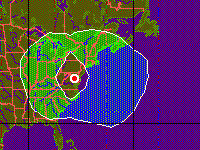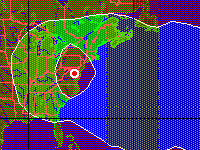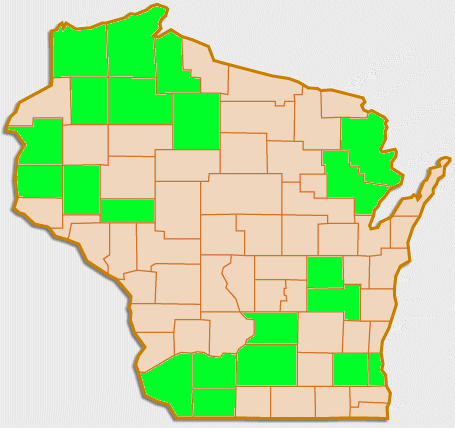



For the 2003 WI QSO party I started with the goal being to work two counties while running half a watt. You see at the start of the contest I had already worked 70 of the 72 counties in the state at half a watt or less. The two counties that I was missing were Kewaunee and St Croix. Both of those had already been worked QRP. From the county hunter forum on one of the web sites I knew there were three mobiles who were planning to be in St Croix county. There were none listed for Kewaunee county. So I at least had a chance of working St Croix. I would have to take my chances on getting Kewaunee.
I decided early on to stick strickly with 20 meters. Had I been able to stay until the end of the contest I likely would have tried 40 meters as well.
The first mobile to make it to St Croix was K5OT. His route took him to Buffalo, Pepin, Pierce, St Croix and then to Dunn counties. I heard him early on in Buffalo and Pepin counties. I even tried to work him in those two, but he never heard me. That did not look good. Actually propagation was not tested as I missed him in both Pierce and St Croix only to hear him again in Dunn county. I was zero for one.
The next on the list was W9HB. He was running counties starting with Barron, Polk and St Croix. The first county I head him in was St Croix. So I felt lucky. Unfortunately he, like K5OT, could not hear me. I was zero for two.
The last chance was with NE9U. He had a longer route to St Croix. The trip took him through Bayfield, Ashland, Sawyer, Rusk, Barron, Polk, and then into St Croix. He must have had a better antenna. It was looking good when we worked when he was in Bayfield and then again when he got to Ashland. But then the luck turned. In two of the following three counties I heard him and tried to work him, but he could not copy me. Finally I head him in Polk county. It took a while, then with a struggle he managed to put me in the log. Not two minutes later he drove into St Croix. I could only wish we had made the QSO a couple of minutes later. However with some effort, and after others who were trying to get the county thinned out we managed a QSO. One of the two counties I need was in the log.
I never did hear anyone in Kewaunee county. With family commitments I was only able to work the first four hours of the contest. So perhaps someone made it there later.
However in trying to work St Croix county I also got into to playing around in the contest. The map below illustrates the results of that effort. In the end I put 22 of the 72 counties in the log at 500 mWatts. The ones that made it into the log are colored in green. Total take was 30 QSOs.
 Now 500 mWatts is not a lot of power. I ran the contest with a K1 hooked up to a 10 meter extended double zepp which was conveniently pointed towards WI. The is the antenna that L.B.Cebik, W4RNL, recommends as a good wire antenna for 20 meters to 10 meters when fed with ladder line. In simple terms the antenna is a dipole with each leg cut at 22 ft. L.B. recommends that you put it at a greater height than I have mine. But it worked. It certainly, however, cannot compete with a Yagi.
Now 500 mWatts is not a lot of power. I ran the contest with a K1 hooked up to a 10 meter extended double zepp which was conveniently pointed towards WI. The is the antenna that L.B.Cebik, W4RNL, recommends as a good wire antenna for 20 meters to 10 meters when fed with ladder line. In simple terms the antenna is a dipole with each leg cut at 22 ft. L.B. recommends that you put it at a greater height than I have mine. But it worked. It certainly, however, cannot compete with a Yagi.
So what made it possible to complete those 30 QSOs? The very simple answer is there really was nothing special about it. With a reasonable antenna and a little bit of cooperation form old Sol such QSOs can occur quite regularly. I modeled the propagation that day using the ACE-HF propagation software. The maps at the top of the page were created from the ACE-HF software for March 2003 assuming a sunspot number of 140, a dipole on my end of the path and a vertical on the other end. They show the propagation on 20 meters. The dipole probably underestimates my antenna. The vertical overstates what a mobile whip can do. The map also assumes that I am ransmitting at one watt. That is the lowest power the software will allow. The difference between one watt and the 500 mWatts I was running makes the propagation look a bit better than it should be. The map illustrates the single hop propogation for the day. It is centered on my QTH in MD. It show the area where I should have at least a 50% reliability for making the QSO. You can see visually the area which is both too close and to far to complete a QSO on 20 meters. The first map is for the start of the contest. The second map show the propagation when I had to quit the contest. It is very clear that completing QSOs from MD to WI at my power level was very much on the margin. What is also shows it that I should not be at all surprised to be able to complete some QSOs at those power levels. In fact if the fixed stations I worked has a yagi rather than a vertical the odds would have been even more in my favor .
How the State map was made
Making the map was very simple. I obtained the basic county outline map from worldatlas.com with their permission. I then edited the image by changing the color of the counties I worked to green.